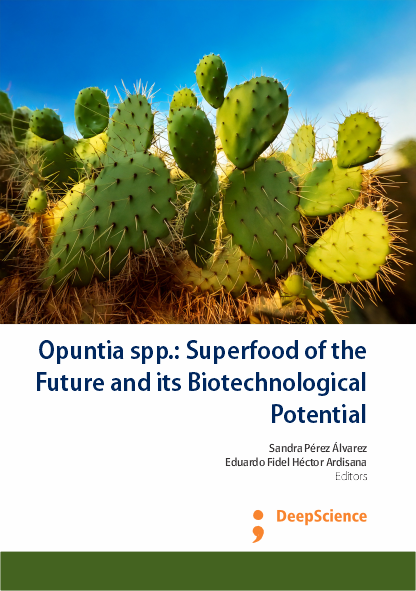The Future of Opuntia spp.: Sustainability and Global Impact
Synopsis
The future Earth is envisioned as a world with an ever-growing population that will increasingly demand food, housing, various services, and technological products. The fulfillment of these needs is limited by the depletion of natural resources, as the rate of product and service generation does not guarantee their timely renewal. It is already possible to estimate the exact day each year when the planet’s resource consumption surpasses its capacity for replenishment. Alarmingly, while this point was reached in December back in 1971, it has been occurring earlier each year. From 2021 to 2024, the so-called "Earth Overshoot Day" has fallen in August (Earth Overshoot, w.d.).
Among the resources that limit the sustainability of our global ecosystem is water (Dolan et al., 2021), which is consumed in great amounts in agriculture, industry, mining, and other human activities. The ecological footprint of human activities takes into account their impact on elements such as cultivated land, forest areas, carbon dioxide emissions, fishing zones, grazing areas, and urbanized regions (Carlsen, 2024).
In the agricultural and livestock sector, the consumption of water, fertilizers, pesticides, processed animal feed, fuels, and other inputs—along with their resulting ecological footprint—is of significant magnitude. As a future projection toward achieving sustainable agriculture, it is essential to establish crops that can provide acceptable yields and a diverse range of products at low ecological costs.
The genus Opuntia, belonging to the family of Cactaceae, is native to Mesoamerica and includes over 300 species that have spread to the rest of the continent, in addition to to Asia, Africa, Australia, and the Mediterranean (Corral-Martínez et al., 2024). Species of this genus perform photosynthesis through the process known as Crassulacean Acid Metabolism (CAM): at night, they open their stomata and assimilate CO₂, which they convert and store as malate in their vacuoles, and during the day, they complete the rest of the photosynthetic process (Niechayev et al., 2023). This characteristic, along with anatomical modifications in their leaves and cladodes, makes them highly efficient in water use. Additionally, Opuntia species have multiple applications not only in human but also in animal nutrition, biotechnology, the pharmacological industry, and even electricity generation (Corral-Martínez et al., 2024), highlighting their potential for future agriculture.
This section analyses the uses of the Opuntia genus and the latest research findings on this topic.
- Diversity of The Opuntia Genus Uses
The flowers, cladodes, and fruits of Opuntia species have been used by humans for various purposes since earliest eras. Advances in scientific knowledge regarding the biological, chemical, and physical properties of these plants have allowed for the diversification of their applications. Below is a brief analysis of the main areas in which these biological materials are utilized.
Human food and nutraceutical properties
When the Spanish arrived in America, the consumption of Opuntia fruits had already spread across the continent. Upon reaching the island they called La Española (now the Dominican Republic and Haiti), they observed the natives eating these fruits and tried them for the first time (Ochoa & Barbera, 2018). Some species produce sweet fruits, such as O. ficus-indica, the greatest widely cultivated; others, such as O. robusta, O. joconostle, and O. streptacantha, produce sour fruits. In all cases, the fruits contain vitamins, minerals, antioxidants, and other bioactive compounds (Corral-Martínez et al., 2024). Indeed, such properties of the edible parts of these plants make them valuable foods, not only for their taste but also for their health benefits and nutritional value.
Among the substances with detectable nutritive and medicinal properties in O. ficus-indica is inulin (Di Bella et al., 2022), a carbohydrate whose consumption reduces cholesterol and blood sugar levels, increases calcium absorption, acts as a probiotic, and helps control body weight. Amino acids such as glutamine (in the cladodes), glutamic acid (in the seeds), proline, and taurine (in the fruits) are also present (Shoukat et al., 2023). It additionally includes fatty acids such as linoleic acids, oleic, and palmitic (Albergamo et al., 2022), which, with adequate intake, can be beneficial to health. Vitamins such as ascorbic acid, tocopherol in its various forms, folic acid, niacin, and others are present in several parts of the crop in varying concentrations (Shoukat et al., 2023).
Opuntia ficus-indica L. (Mill.) contains minerals such as iron, magnesium, potassium, calcium, and phosphorus, in addition to various bioactive substances. Among them, polyphenols, pigments like anthocyanins, and carotenoids have antioxidant properties (Berrabah et al., 2019). For this reason, it has been included as an additive in food. Aiello et al. (2018) prepared a wheat paste with 3% O. ficus-indica extracts, and in a study with volunteers, they detected hypoglycemic, anti-inflammatory, and antioxidant effects, which could have an impact on diseases associated with aging. Oniszczuk et al. (2020) prepared a similar product with rice and bean flour, to which they added O. ficus-indica fruits in proportions ranging from 2.5% to 15%. At higher concentrations, an increase in polyphenols and free phenolic acids, primarily isoferulic acid, was observed, along with high antioxidant activity in the food, making it potentially useful as a source of these important compounds.
Undoubtedly, the value of the Opuntia genus as food or dietary supplement goes beyond the nutrients it contains and focuses on nutraceuticals, considering the presence of health-beneficial substances in the species that make it up. Even in the peel of the fruits, which is typically discarded for consumption, substances with antioxidant activity have been detected in Opuntia dillenii, Opuntia ficus-indica, and Opuntia robusta (Marhri et al., 2024), highlighting an untapped potential in these species. Interestingly, due to their sour or slightly acidic taste, the fruits of O. robusta and O. dillenii are not highly appreciated for direct consumption. However, they could be useful as additives and supplements in other food products, as the nutraceutical value of these sour fruits, also known as "xoconostles," has also been demonstrated.
Fernández-Luqueño et al. (2021) detailed the properties of extracts from xoconostles, either for direct consumption or as part of meat, dairy, and fruit products. Among the highlighted species are Opuntia matudae, with effects on diabetes, obesity, and respiratory diseases, as well as others like O. joconostle, O. duranguensis, and O. oligacantha.














